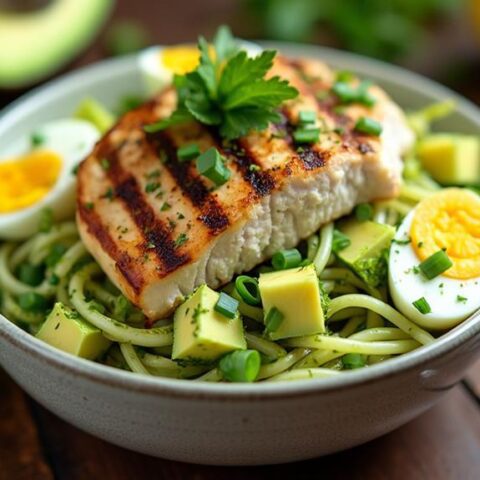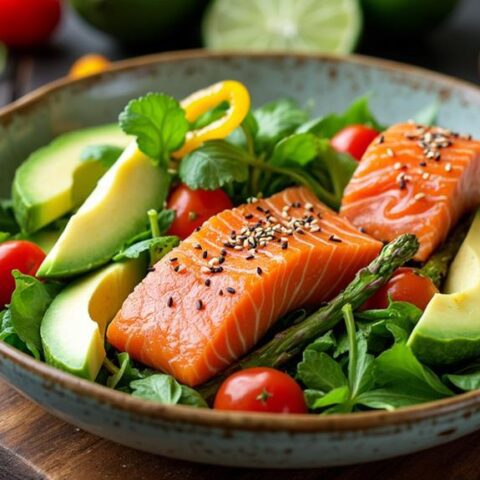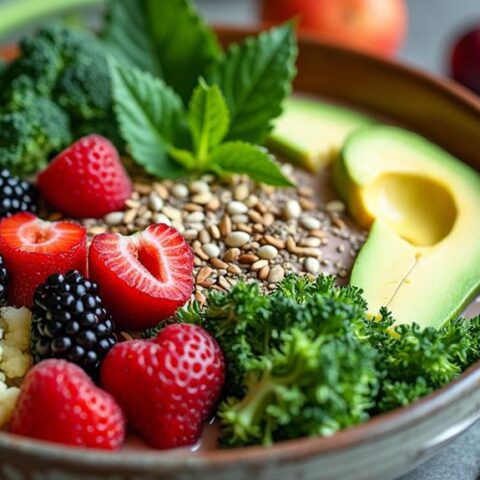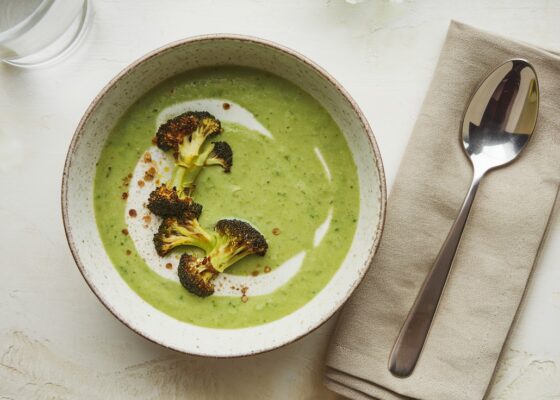
Several grains stand out as lower-carb alternatives to traditional staples. Wild rice contains 16.5 grams of net carbs per half-cup, while bulgur offers 13 grams, and quinoa provides 17 grams. Popcorn emerges as particularly low-carb with just 5.1 grams per cup. These options deliver essential nutrients, fiber, and protein while supporting blood sugar management and weight control goals. Understanding proper portion sizes and preparation methods reveals the full potential of these nutritious alternatives.
Key Takeaways
- Wild rice contains 16.5 grams of net carbs per half-cup, making it one of the lower-carb grain options available.
- Bulgur stands out at 13 grams of net carbs per half-cup serving and provides significant fiber content.
- Popcorn offers a surprisingly low-carb option with only 5.1 grams of net carbs per cup serving.
- Quinoa provides 17 grams of net carbs per half-cup while delivering complete protein and essential nutrients.
- Millet, a gluten-free grain, contains 18.9 grams of net carbs per half-cup serving.
Understanding Net Carbs in Grains
When calculating the carbohydrate content of grains for a low-carb diet, understanding net carbs provides a more accurate picture of their impact on blood sugar levels.
Net carbs are determined by subtracting fiber content from total carbohydrates, helping individuals make informed choices about which grains are low in digestible carbohydrates.
Understanding net carbs helps you choose smarter grain options by focusing on digestible carbohydrates rather than total carb content.
Common grain options vary considerably in their net carb content. Cooked oats contain 23 grams of net carbs per cup, while cooked quinoa provides 34 grams per cup.
Cooked bulgur emerges as a particularly suitable option for low carb diets, offering just 13 grams of net carbs per half-cup serving. Wild rice, with 16.5 grams of net carbs per half-cup, represents another mindful choice.
The high fiber content in these grains not only reduces their net carb impact but also supports digestive health.
Essential Low-Carb Grain Options
Several grain alternatives offer lower net carb counts while maintaining nutritional value, with options like quinoa and bulgur providing significant fiber content to offset their total carbohydrates.
When comparing net carbs, popcorn emerges as a particularly favorable choice with just 5.1 grams of net carbs per cup, while wild rice and millet present moderate options at 16.5 and 18.9 grams of net carbs per half cup, respectively.
Managing portion sizes becomes essential for incorporating these alternatives into a low-carb lifestyle, with recommended servings typically ranging from half to one cup depending on individual dietary goals and daily carb allowances.
Best Low-Carb Grain Alternatives
While traditional grains can be high in carbohydrates, several nutritious alternatives offer lower net carb counts without sacrificing taste or versatility. Among healthy whole grains, bulgur stands out with just 13 grams of net carbs per serving, while being high in fiber. Quinoa and wild rice provide excellent options for those seeking low carb grains, containing 17 and 16.5 grams of net carbs respectively.
| Grain | Net Carbs (g) | Key Benefit |
|---|---|---|
| Bulgur | 13 | High Fiber |
| Wild Rice | 16.5 | Nutty Flavor |
| Quinoa | 17 | Complete Protein |
These alternatives not only support various dietary needs but also offer distinct nutritional advantages, making them valuable additions to a health-conscious meal plan. Each option brings unique flavors and textures, ensuring satisfying meal experiences while maintaining lower carbohydrate intake.
Comparing Net Carb Contents
Understanding the net carb content of various grain alternatives proves essential for individuals following low-carb dietary plans.
When comparing options, steel-cut oats emerge as one of the lowest choices with 23 grams of net carbs per cup, while bulgur follows with 26 grams.
For those seeking variety in their low carbohydrate lifestyle, several options present distinct nutritional profiles:
- A cup of cooked quinoa contains 34 grams of net carbs while offering substantial protein content
- Bulgur, high in fiber, provides 26 grams of net carbs per serving
- Cooked wild rice delivers 32 grams of net carbs with beneficial antioxidants
- Millet, though higher at 39 grams per cup, remains a viable gluten-free alternative
These options allow for informed decisions based on specific dietary needs and net carb count preferences while maintaining nutritional value.
Smart Portion Control Tips
Successful portion control stands as a cornerstone of maintaining a low-carb diet when incorporating grains into meal plans. Understanding net carbs and carefully measuring servings helps individuals manage their carbohydrate intake effectively while enjoying wholesome grains.
For instance, measuring out a half-cup of quinoa or wild rice guarantees proper portion sizes while providing essential nutrients.
To optimize portion control, combining low-carb grains with healthy fats and fiber-rich vegetables can create satisfying meals without exceeding carbohydrate limits. Utilizing measuring cups, food scales, or visual guides helps maintain consistent serving sizes of whole grains like bulgur or steel-cut oats.
Additionally, incorporating alternatives such as cauliflower rice allows for larger portions while keeping net carbs minimal, making it easier to stick to portion guidelines within a low-carb eating plan.
Health Benefits of Whole Grain Alternatives
The remarkable health benefits of whole grain alternatives extend far beyond basic nutrition, offering a powerful combination of fiber, nutrients, and protective compounds.
Research consistently demonstrates that incorporating whole grains into daily meals can notably lower the risk of chronic diseases while providing essential vitamins and minerals necessary for ideal health.
- Whole grains help maintain healthy cholesterol levels and support cardiovascular function through their rich fiber content.
- Regular consumption stabilizes blood sugar levels, reducing the risk of developing type 2 diabetes.
- The high fiber content promotes weight management by increasing satiety and reducing cravings.
- These grains deliver vital nutrients, including magnesium, iron, and B vitamins, supporting various metabolic processes.
These benefits make whole grain alternatives an intelligent choice for those seeking to improve their overall health while managing carbohydrate intake effectively.
Smart Swaps for High-Carb Classics
Making the switch from traditional carb-heavy ingredients to healthier alternatives can transform everyday meals into nutritious options. Cauliflower rice stands out as an excellent substitute for pasta and regular rice, offering a mere 2 grams of net carbs per serving while maintaining satisfying texture and versatility. Ancient grains like quinoa and bulgur present compelling options for those seeking to reduce carbohydrate intake while preserving nutritional benefits, as they contain fewer net carbs and higher amounts of protein and fiber than their conventional counterparts. Including non-starchy vegetables such as spinach, kale, and broccoli in your diet can further support nutrient intake without disrupting low-carb goals.
Cauliflower Rice Vs Pasta
Health-conscious individuals seeking to reduce their carbohydrate intake can find remarkable alternatives in cauliflower rice and zucchini noodles, which offer dramatic reductions in both carbs and calories compared to traditional pasta and rice dishes.
These versatile substitutes provide significant nutritional benefits while maintaining satisfying textures and flavors:
- Cauliflower rice contains only 2 grams of net carbs per cup, compared to traditional rice's 45 grams.
- Zucchini noodles offer just 3 grams of net carbs per cup versus pasta's 40 grams.
- Switching to cauliflower rice saves approximately 200 calories per serving.
- Both alternatives are rich in vitamins and minerals while supporting creative meal preparation.
These low-carb alternatives integrate seamlessly into various dishes, from stir-fries to salads, making them practical choices for anyone monitoring their carbohydrate consumption.
Ancient Grains Worth Trying
While cauliflower rice and zucchini noodles offer excellent low-carb alternatives, ancient grains present compelling options for those seeking smart substitutions with balanced nutritional profiles.
For those monitoring their net carbs while wanting to maintain nutritional variety, several ancient grain options deserve consideration. Quinoa stands out as a complete protein source with 34 grams of net carbs per cup cooked, while bulgur offers a lower-carb profile at 26 grams per cup.
Wild rice provides antioxidant benefits with 32 grams of net carbs, and gluten-free millet contains 39 grams per cup cooked. Spelt, though higher in carbohydrates at 43.5 grams per cup, delivers significant health benefits through its nutrient density.
These alternatives can be incorporated strategically into a low-carb eating plan, offering both variety and essential nutrients.
Cooking Tips for Low-Carb Grains
Successful preparation of low-carb grains requires attention to specific cooking ratios and techniques that maximize both flavor and nutritional value.
Using a 1:2 ratio of grain to water guarantees ideal texture, while pre-soaking certain grains like millet can enhance digestibility and reduce cooking time.
Pre-soaking and using proper water ratios ensures your grains achieve the perfect texture while becoming more digestible and quicker to prepare.
To develop a rich, nutty flavor profile, consider toasting grains before boiling them in water.
- Add aromatic herbs and spices during cooking to enhance the natural flavors
- Pre-soak grains for 6-8 hours to improve texture and digestibility
- Toast grains in a dry skillet until fragrant before adding water
- Incorporate healthy fats like olive oil when using grains in salads
These cooking tips transform low-carb grains into versatile ingredients that can raise numerous dishes while maintaining their nutritional benefits.
Portion Control and Carb Management
Managing portion sizes and tracking carbohydrate intake are essential components of successfully incorporating low-carb grains into a balanced diet. Understanding serving sizes helps maintain healthy carb limits while enjoying nutritious grains.
For example, a half-cup serving of cooked quinoa contains approximately 20 grams of net carbs, while wild rice contains 32 grams per cup.
To optimize blood sugar control, focus on grains that provide a fiber boost of at least 3 grams per serving. High-fiber options like barley and oats help slow carbohydrate absorption, making them valuable additions to a low-carb eating plan.
When selecting low-carb grains such as bulgur or millet, which contain between 13 and 19 grams of net carbs per serving, careful measurement guarantees staying within daily carbohydrate goals.
Ancient Grains for Modern Diets
The resurgence of ancient grains in modern nutrition has revolutionized how health-conscious individuals approach their carbohydrate choices. While not strictly low carb, these grains offer superior nutritional value compared to refined alternatives, making them worthy considerations for balanced diets.
- Quinoa stands out with 34.2g net carbs and 8.1g protein per cooked cup, offering complete protein for those monitoring carb intake.
- Teff provides 25g carbs per half-cup serving while delivering essential calcium and fiber.
- Farro combines 34g carbs with 7g protein per cup, supporting digestive health through fiber content.
- Kamut delivers 30g net carbs and an impressive 11g protein per cup, ideal for those seeking nutrient-dense options.
These ancient grains can be strategically incorporated into modern diets through mindful portion control, offering diverse nutrients while maintaining carbohydrate awareness.
Weight Loss-Friendly Grain Choices
Building upon the nutritional wisdom of ancient grains, selecting weight-friendly grain options creates a foundation for sustainable weight management. Whole grains like bulgur and quinoa stand out as superior choices, with bulgur providing 8.2 grams of fiber per cup to promote satiety.
Quinoa's complete protein profile makes it an excellent replacement for higher-carb alternatives, while supporting weight loss goals through its nutritional density.
For those seeking low-carb options, wild rice offers a strategic choice with 31.9 grams of net carbs per cup, while steel-cut oats provide beta-glucans for appetite control.
Research demonstrates that individuals who choose whole grains over refined grains experience more successful weight loss outcomes, highlighting the importance of grain selection in dietary planning.
Meal Planning With Low-Carb Grains
Successful meal planning with low-carb grains requires strategic selection and thoughtful portioning to maintain nutritional balance while managing carbohydrate intake. When incorporating options like quinoa, bulgur, and millet into weekly meal plans, understanding their net carb content enables better portion control and dietary management. These versatile grains can form the foundation of numerous healthy dishes while keeping carbohydrate levels in check. Quinoa and bulgur work well as nutrient-rich bases for grain bowls, offering approximately 17 grams of net carbs per half-cup serving. Barley can be prepped in advance for soups and side dishes, containing about 19 grams of net carbs per half-cup. Millet serves as an excellent foundation for salads with its 19 grams of net carbs per half-cup. Effective meal planning reduces food waste and manages hunger, enabling variety while maintaining controlled carbohydrate intake.
Shopping Guide for Grain Alternatives
Making smart grain substitutions requires understanding both nutritional content and cost-effectiveness when shopping for low-carb alternatives.
Shoppers can identify budget-friendly options by comparing unit prices of whole grain alternatives like quinoa and millet against traditional refined grains, while also considering their longer shelf life and versatility in recipes.
Success in selecting appropriate grain alternatives depends on carefully examining nutrition labels for key metrics such as fiber content, net carbs, and serving sizes, enabling consumers to make informed choices that align with their dietary goals.
Smart Grain Swaps Guide
While moving to a low-carb lifestyle can feel overwhelming, selecting the right grain alternatives at the grocery store transforms this challenge into a manageable task.
Smart substitutions help maintain nutritional balance while reducing carbohydrate intake. Consider these practical grain swaps for everyday meals:
- Replace white rice with cauliflower rice to cut carbs to just 2 grams per serving.
- Swap traditional bread with rye bread, offering 13 grams of net carbs per slice and higher fiber content.
- Choose quinoa or bulgur over conventional grains, providing 17 and 13 grams of net carbs respectively.
- Consider wild rice for special occasions, with 16.5 grams of net carbs and enhanced nutritional benefits.
For snacking options, air-popped popcorn presents an excellent low-carb choice at only 5 grams of net carbs per cup.
Finding Budget-Friendly Alternatives
Shopping for low-carb grain alternatives need not strain the household budget when armed with smart strategies and insider knowledge. Savvy consumers can explore whole grains like quinoa and bulgur, which offer superior nutritional value while maintaining lower net carb counts than processed options.
Budget-conscious shoppers benefit from purchasing these staples in bulk, particularly when combining this approach with seasonal sales and promotions. Local markets often provide fresh, affordable alternatives, including versatile options like cauliflower rice, which serves as an excellent substitute for traditional grains.
Additionally, exploring ethnic grocery stores can reveal unique, cost-effective whole grain varieties that align with low-carb dietary goals. By planning purchases around store specials and embracing creative alternatives, health-conscious consumers can maintain their low-carb lifestyle without compromising their financial well-being.
Reading Nutrition Labels Effectively
Successful navigation of nutrition labels forms the cornerstone of smart shopping for low-carb grain alternatives.
When examining labels, calculating net carbs requires subtracting dietary fiber from total carbohydrates, an essential consideration for low-carb diets. Understanding serving sizes prevents unintentional overconsumption, especially since many grain products contain multiple servings per package.
- Check whole grain options for minimum 3 grams each of fiber and protein per serving
- Calculate net carbs by subtracting fiber from total carbohydrates
- Monitor added sugars, which can greatly increase carbohydrate content
- Compare nutritional profiles of grain alternatives like quinoa and bulgur
When evaluating nutrition labels, particular attention should be paid to hidden sources of carbs, including added sugars and refined grains, which can derail health goals despite appearing in seemingly healthy products.
Preparing Grains for Maximum Nutrition
Proper preparation techniques make a significant difference in revealing the full nutritional potential of low-carb grains.
To maximize nutrition, soaking quinoa before cooking removes bitter-tasting saponins while improving digestibility and nutrient absorption.
Soak quinoa before cooking to eliminate bitter compounds and enhance both nutritional value and digestive benefits.
Bulgur preparation requires minimal effort, as it needs only hot water soaking for 12-15 minutes to retain fiber and achieve a fluffy texture.
For best health benefits, selecting steel-cut or rolled oats over instant varieties preserves essential nutrients and supports heart health.
Wild rice demands specific attention to proportions, using a 1:3 ratio of rice to water and extended simmering time for ideal texture.
When preparing grains like millet and barley, incorporating herbs and spices during cooking not only enhances flavor but also introduces additional nutritional benefits.
Recipe Ideas Using Low-Carb Grains
Creating delicious meals with low-carb grains opens up a world of nutritious possibilities while maintaining dietary goals. From invigorating salads to hearty side dishes, these versatile ingredients offer numerous recipe ideas while keeping net carbs in check.
- Transform quinoa into a nutrient-dense salad with fresh vegetables and vinaigrette, containing just 17 grams of net carbs per half cup.
- Prepare traditional tabbouleh using bulgur, mixed with parsley and fresh vegetables, offering 13 grams of net carbs per serving.
- Cook wild rice with vegetable broth and sautéed mushrooms for a satisfying side dish at 16.5 grams of net carbs.
- Replace conventional rice with cauliflower rice in stir-fries, maintaining only 2 grams of net carbs per serving.
- Steel-cut oats can be reimagined as a savory breakfast bowl topped with avocado and eggs, providing a hearty start to the day.
The ketogenic diet significantly improves insulin sensitivity, which is crucial for managing type 2 diabetes.
Frequently Asked Questions
What Grains Are Lowest in Carbs?
Among these grain alternatives, bulgur ranks lowest in net carbs at 13g per serving, making it suitable for low carb meal planning, followed by wild rice and quinoa as moderately keto-friendly options.
What Is the Best Low-Carb Staple Food?
Rye bread emerges as a superior low-carb alternative, offering ideal nutrient density and fiber content. Its versatility supports meal prepping while facilitating portion control, making it an excellent staple for grain-free recipes.
What's the Worst Carb for Belly Fat?
Refined carbohydrate sources, particularly white bread and sugary cereals, rank worst for belly fat accumulation. These foods spike insulin resistance, hindering weight loss efforts regardless of exercise routine or dietary balance.
Does the NHS Recommend a Low-Carb Diet?
The NHS does not officially recommend low-carb diets, instead promoting balanced nutrition with adequate dietary fiber from diverse carbohydrate sources. Weight loss strategies focus on overall healthy eating patterns and sustainable health implications.
Conclusion
Low-carb grains offer viable alternatives for health-conscious individuals seeking to reduce their carbohydrate intake while maintaining nutritional benefits. By incorporating options like quinoa, bulgur, and wild rice into meal planning, along with smart preparation techniques and creative recipe adaptations, anyone can successfully shift to a lower-carb lifestyle. Understanding net carbs, proper portion sizes, and cooking methods guarantees peak nutrition while satisfying dietary goals through these versatile grain alternatives.









No Comments